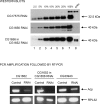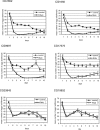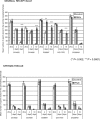Sustained post-mating response in Drosophila melanogaster requires multiple seminal fluid proteins
- PMID: 18085830
- PMCID: PMC2134937
- DOI: 10.1371/journal.pgen.0030238
Sustained post-mating response in Drosophila melanogaster requires multiple seminal fluid proteins
Abstract
Successful reproduction is critical to pass genes to the next generation. Seminal proteins contribute to important reproductive processes that lead to fertilization in species ranging from insects to mammals. In Drosophila, the male's accessory gland is a source of seminal fluid proteins that affect the reproductive output of males and females by altering female post-mating behavior and physiology. Protein classes found in the seminal fluid of Drosophila are similar to those of other organisms, including mammals. By using RNA interference (RNAi) to knock down levels of individual accessory gland proteins (Acps), we investigated the role of 25 Acps in mediating three post-mating female responses: egg production, receptivity to remating and storage of sperm. We detected roles for five Acps in these post-mating responses. CG33943 is required for full stimulation of egg production on the first day after mating. Four other Acps (CG1652, CG1656, CG17575, and CG9997) appear to modulate the long-term response, which is the maintenance of post-mating behavior and physiological changes. The long-term post-mating response requires presence of sperm in storage and, until now, had been known to require only a single Acp. Here, we discovered several novel Acps together are required which together are required for sustained egg production, reduction in receptivity to remating of the mated female and for promotion of stored sperm release from the seminal receptacle. Our results also show that members of conserved protein classes found in seminal plasma from insects to mammals are essential for important reproductive processes.
Conflict of interest statement
Competing interests. The authors have declared that no competing interests exist.
Figures




Similar articles
-
The Drosophila melanogaster seminal fluid protease "seminase" regulates proteolytic and post-mating reproductive processes.PLoS Genet. 2012 Jan;8(1):e1002435. doi: 10.1371/journal.pgen.1002435. Epub 2012 Jan 12. PLoS Genet. 2012. PMID: 22253601 Free PMC article.
-
Acp36DE is required for uterine conformational changes in mated Drosophila females.Proc Natl Acad Sci U S A. 2009 Sep 15;106(37):15796-800. doi: 10.1073/pnas.0904029106. Epub 2009 Sep 1. Proc Natl Acad Sci U S A. 2009. PMID: 19805225 Free PMC article.
-
The sex peptide of Drosophila melanogaster: female post-mating responses analyzed by using RNA interference.Proc Natl Acad Sci U S A. 2003 Aug 19;100(17):9923-8. doi: 10.1073/pnas.1631635100. Epub 2003 Jul 31. Proc Natl Acad Sci U S A. 2003. PMID: 12893873 Free PMC article.
-
"S.P.E.R.M." (seminal proteins (are) essential reproductive modulators): the view from Drosophila.Soc Reprod Fertil Suppl. 2007;65:183-99. Soc Reprod Fertil Suppl. 2007. PMID: 17644962 Review.
-
The gifts that keep on giving: physiological functions and evolutionary dynamics of male seminal proteins in Drosophila.Heredity (Edinb). 2002 Feb;88(2):85-93. doi: 10.1038/sj.hdy.6800017. Heredity (Edinb). 2002. PMID: 11932766 Review.
Cited by
-
Seminal fluid-mediated fitness effects in the simultaneously hermaphroditic flatworm Macrostomum lignano.Ecol Evol. 2019 Nov 18;9(24):13889-13901. doi: 10.1002/ece3.5825. eCollection 2019 Dec. Ecol Evol. 2019. PMID: 31938489 Free PMC article.
-
Temporally variable selection on proteolysis-related reproductive tract proteins in Drosophila.Mol Biol Evol. 2012 Jan;29(1):229-38. doi: 10.1093/molbev/msr197. Epub 2011 Sep 22. Mol Biol Evol. 2012. PMID: 21940639 Free PMC article.
-
An orphan gene is essential for efficient sperm entry into eggs in Drosophila melanogaster.bioRxiv [Preprint]. 2024 Dec 14:2024.08.08.607187. doi: 10.1101/2024.08.08.607187. bioRxiv. 2024. Update in: Genetics. 2025 Mar 17;229(3):iyaf008. doi: 10.1093/genetics/iyaf008. PMID: 39149251 Free PMC article. Updated. Preprint.
-
Immortal coils: conserved dimerization motifs of the Drosophila ovulation prohormone ovulin.Insect Biochem Mol Biol. 2010 Apr;40(4):303-10. doi: 10.1016/j.ibmb.2010.01.009. Epub 2010 Feb 4. Insect Biochem Mol Biol. 2010. PMID: 20138215 Free PMC article.
-
The Drosophila melanogaster seminal fluid protease "seminase" regulates proteolytic and post-mating reproductive processes.PLoS Genet. 2012 Jan;8(1):e1002435. doi: 10.1371/journal.pgen.1002435. Epub 2012 Jan 12. PLoS Genet. 2012. PMID: 22253601 Free PMC article.
References
-
- Malm J, Hellman J, Hogg P, Lilja H. Enzymatic action of prostate-specific antigen (PSA or hK3): substrate specificity and regulation by Zn(2+), a tight-binding inhibitor. Prostate. 2000;45:132–139. - PubMed
-
- Fichter J, Graves HCB, Thatcher K, Yemoto C, Shortliffe LMD. Prostate specific antigen releases a kinin like substance on proteolysis of seminal vesicle fluid that stimulates smooth muscle contraction. J Urol. 1996;155:738–742. - PubMed
Publication types
MeSH terms
Substances
Grants and funding
LinkOut - more resources
Full Text Sources
Molecular Biology Databases

